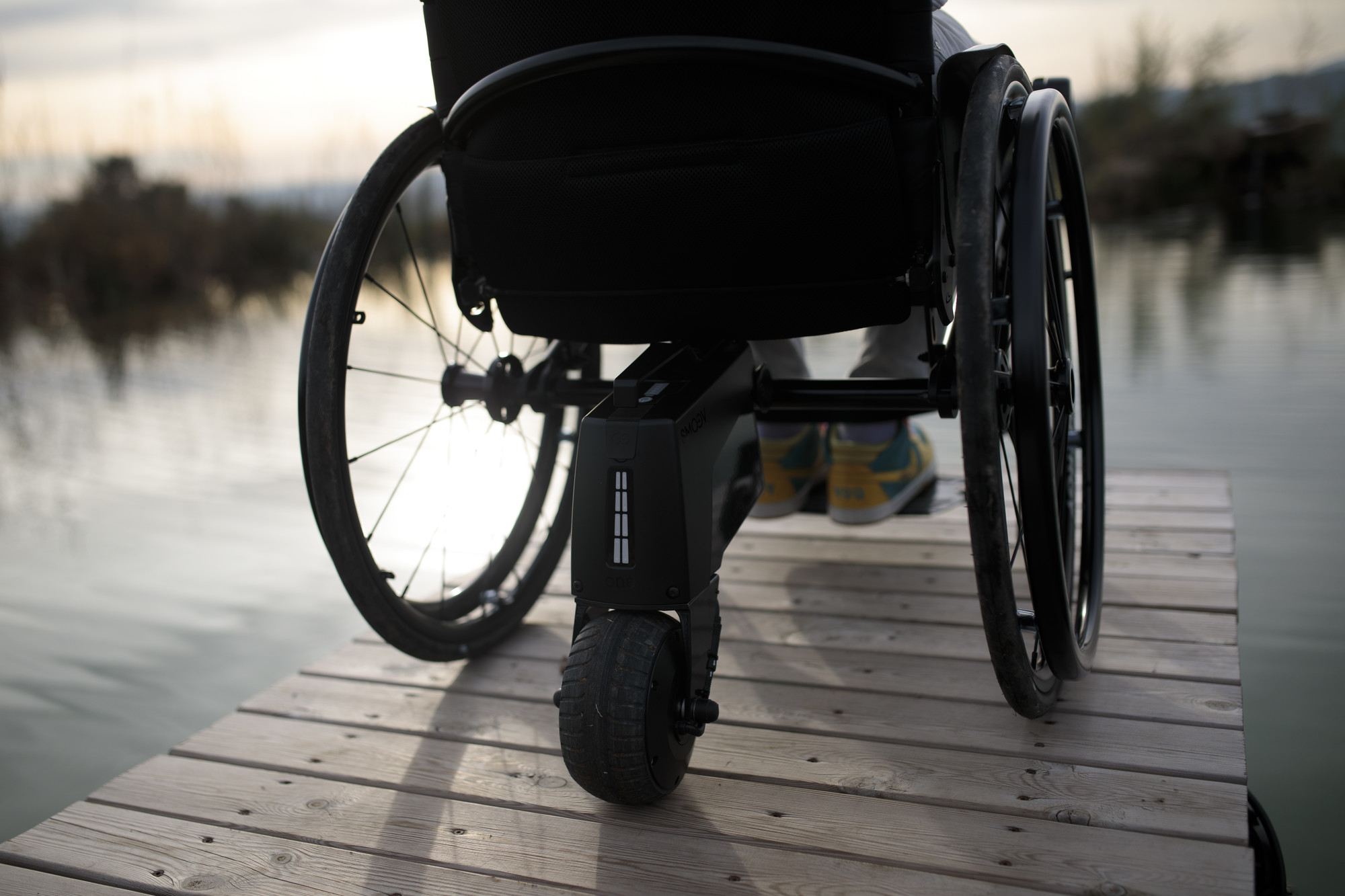
Power assist devices on manual wheelchairs are becoming more and more popular as we become aware of benefits they provide, and new options and designs become available. For manual wheelchair users, a power assist device allows them to propel with less energy expenditure, reducing the strain on the upper limbs and allowing users to extend their functional mobility to include slopes and hills.
The benefits of a power assist device do seem obvious, but it’s still important to review the clinical evidence available to ensure that what is recommended is supported by research. So what does the evidence say?
Firstly, several studies have found that the use of power assist devices do reduce the strain on upper limbs during wheelchair propulsion. One of the main reasons to consider a power assist device is for this reason, as the frequent start movements performed by wheelchair users throughout the day yield high levels of physical stress on the upper extremity1,2. We also know that there is a high incidence of shoulder and upper limb injuries experienced by wheelchair users which impact on propulsion as well as general daily tasks and personal care activities1, so much of the research is focused on whether power assist devices reduce the stress on the upper limbs.
A study in 2016 investigating shoulder load during hand-rim wheelchair start-up found that power assist wheels, such as those with the power through the wheels and handrims like the Alber E-motion, Alber Twion and Quickie Xtender, are effective in reducing external shoulder load and partly effective in reducing extremes of shoulder motion during the initial push off and start up1. A reduction in shoulder abduction and shoulder extension was also found, meaning that less movement and force was needed to start to propel1. These results led the study’s authors to state that the use of power assist wheels might reduce the risk of developing shoulder overuse injuries1.
Two additional studies from 2003 and 2012 and found that the use of power assist devices significant decreased shoulder flexion/extension and adduction and internal rotation movements, elbow flexion/extension, wrist flexion/extension and ulnar/radial deviation2,3, as well as decreasing muscle activation in the pectoralis major, posterior deltoid and triceps brachii2. These studies also support the conclusion that power assist devices can reduce the load and stresses on the upper limbs during wheelchair propulsion.
Other studies have focused on the use of power assist devices for users with reduced exercise capacity. Two studies have noted that power assisted propulsion might be beneficial for users with low cardiopulmonary reserves and low upper extremity strength and endurance4,5. This is linked to the effect that power assist devices have on the physiological performance. Several studies have found that power assist devices result in a lower heart rate elevation, lower perceived exertion, reduced electromyographic activation of muscles and lower oxygen consumption4,5,6,7,8. Power assist devices decrease the biomechanical and physiological stress associated with self-propulsion while preserving the opportunity to exercise while wheeling8.
The functional benefits of power assist devices have been investigated in many studies, and occasionally the results from studies differ. A study by Ding et al (2008) found that users travelled significantly faster when using a power assist device, but this study also found the distances travelled by users with and without their power assist device did not differ significantly, and that power assist did not result in significantly greater community participation, satisfaction, and psychosocial impacts9. Kloosterman and fellow researchers (2013) also report that social participation was not affected significantly by the use of a hand-rim, powered or power-assisted wheelchair5.
In contrast, several other studies found that power assist devices offered users more independence and social opportunities10,11,12, and a study reported that nine of eleven elderly users thought they would venture to new and different places in a power-assist wheelchair6. A qualitative study reported that participants found the power assist wheelchair was easier and less demanding to propel than a manual chair, improving both efficiency and speed, and these benefits increased the scope of opportunities to engage in community-based occupations11.
Power assist devices have also been shown to enable users to perform some mobility tasks more quickly and allowed some users to perform some mobility tasks they were unable to perform in their regular manual wheelchair13. Several studies report that obstacles like ramps, inclines, curb cuts and carpet were much easier for wheelchair users to navigate with a power assist due to the additional torque it provides5,6,7,11.
Overall, the evidence supports the use of power assist devices to reduce the strain on the upper extremities and allow people who have difficulty propelling long distances or up inclines the ability to access the community more easily. There are several different types of power assist devices, and your GTK consultant can help determine which could be the most suitable. Contact us today for more information on power assist devices or to arrange a trial.
References
- Kloosterman, M.G.B., Buurke, J.H., Schaake, L., Van Der Woude, L.H.V. & Reitman, J.S. (2016). Exploration of shoulder load during hand-rim wheelchair start-up with and without power-assisted propulsion in experienced wheelchair users. Clinical Biomechanics, 34, 1-6.
- Kloosterman, M.G.B., Eising, H., Schaake, L., Buurke, J.H. & Reitman, J.S. (2012). Comparison of shoulder load during power-assisted and purely hand-rim wheelchair propulsion. Clinical Biomechanics, 27(5), 428-435
- Corfman, T.A., Cooper, R.A., Boninger, M.L., Koontz, A.M. & Fitzgerald, S.G. (2003). Range Of motion and stroke frequency differences between manual wheelchair propulsion and pushrim-activated power-assisted wheelchair propulsion. The Journal of Spinal Cord Medicine, 26(2), 135-140.
- Cooper, R.A., Fitzgerald, S.G., Boninger, M.L., Prins, K., Rentschler, A.J., Arva, J. & O’Connor, T.J. (2001) Evaluation of a pushrim-activated, power-assisted wheelchair. Archives of Physical Medicine & Rehabilitation, 86(5), 702-708.
- Kloosterman, M.G.M., Snoek, G.J., van der Woude, L.H.V., Buurke, J.H. & Rietman, J.S. (2013). A systematic review on the pros and cons of using a pushrim-activated power-assisted wheelchair. Clinical Rehabilitation, 27(4), 299–313.
- Levy, C.E., Chow, J.W., Tillman, M.D., Hanson, C., Donohue, T. & Mann, W.C. (2004) Variable-ratio pushrim-activated power-assist wheelchair eases wheeling over a variety of terrains for elders. Archives of Physical Medicine & Rehabilitation,85(1),104-12.
- Algood, S.D., Cooper, R.A., Fitzgerald, S.G., Cooper, R. & Boninger. M.L. (2005). Effect of a pushrim-activated power-assist wheelchair on the functional capabilities of persons with tetraplegia. Archives of Physical Medicine & Rehabilitation, 86(3),380-386.
- Levy, C.E. & Chow, J.W. (2004). Pushrim-activated power-assist wheelchairs: Elegance in motion. American Journal of Physical Medicine & Rehabilitation, 83(2), 166-167.
- Ding, D., Souza, A., Cooper, R.A., Fitzgerald, S.G., Cooper, R., Kelleher, A. & Boninger, M.L. (2008) A Preliminary Study on the Impact of Pushrim-Activated Power-Assist Wheelchairs Among Individuals with Tetraplegia. American Journal of Physical Medicine & Rehabilitation, 87(10), 821-829
- Giacobbi, P.R., Levy, C.E., Dietrich, F.D., Winkler, S.H., Tillman, M.D. & Chow, J.W. (2010). Wheelchair users' perceptions of an experiences with power assist wheels. American Journal of Physical Medicine & Rehabilitation, 89(3), 225-234
- Giesbrecht, E.D., Ripat, J.D., Cooper, J.E. & Quanbury, A.O. (2011). Experiences with using a pushrim-activated power-assisted wheelchair for community-based occupations: A qualitative exploration. Canadian Journal of Occupational Therapy, 78(2), 127-136.
- Levy, C.E., Buman, M.P., Chow, J.C., Tillman, M.D., Fournier, K.A., & Giacobbi, P. (2010). Use of power assist-wheels results in increased distance traveled compared to conventional manual wheeling. American Journal of Physical Medicine and Rehabilitation, 89(8), 625-634.
- Sawatzky, B., Mortenson, W.B. & Wong, S. (2018) Learning to use a rear-mounted power assist for manual wheelchairs. Disability and Rehabilitation: Assistive Technology, 13(8), 772-776





